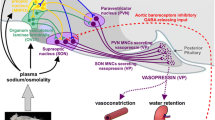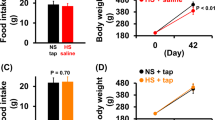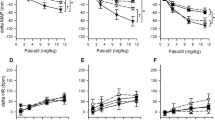Abstract
Excess dietary salt intake is a major contributing factor to the pathogenesis of salt-sensitive hypertension. Strong evidence suggests that salt-sensitive hypertension is attributed to renal dysfunction, vascular abnormalities, and activation of the sympathetic nervous system. Indeed, sympathetic nerve transections or interruption of neurotransmission in various brain centers lowers arterial blood pressure (ABP) in many salt-sensitive models. The purpose of this article is to discuss recent evidence that supports a role of plasma or cerebrospinal fluid hypernatremia as a key mediator of sympathoexcitation and elevated ABP. Both experimental and clinical studies using time-controlled sampling have documented that a diet high in salt increases plasma and cerebrospinal fluid sodium concentration. To the extent it has been tested, acute and chronic elevations in sodium concentration activates the sympathetic nervous system in animals and humans. A further understanding of how the central nervous system detects changes in plasma or cerebrospinal fluid sodium concentration may lead to new therapeutic treatment strategies in salt-sensitive hypertension.

Similar content being viewed by others
References
Papers of particular interest, published recently, have been highlighted as: • Of importance •• Of major importance
Appel LJ. Another major role for dietary sodium reduction: improving blood pressure control in patients with resistant hypertension. Hypertension. 2009;54(3):444–6.
Appel LJ et al. The importance of population-wide sodium reduction as a means to prevent cardiovascular disease and stroke: a call to action from the American Heart Association. Circulation. 2011;123(10):1138–43.
He FJ et al. Plasma sodium: ignored and underestimated. Hypertension. 2005;45(1):98–102.
Kotchen TA, Cowley Jr AW, Frohlich ED. Salt in health and disease—a delicate balance. N Engl J Med. 2013;368(13):1229–37.
Strazzullo P et al. Salt intake, stroke, and cardiovascular disease: meta-analysis of prospective studies. BMJ. 2009;339:b4567.
Chobanian AV et al. Seventh report of the Joint National Committee on Prevention, Detection, Evaluation, and Treatment of High Blood Pressure. Hypertension. 2003;42(6):1206–52.
Mancia G et al. 2013 ESH/ESC Guidelines for the management of arterial hypertension: The Task Force for the management of arterial hypertension of the European Society of Hypertension (ESH) and of the European Society of Cardiology (ESC). Eur Heart J. 2013;34(28):2159–219.
King AJ et al. Whole body norepinephrine kinetics in ANG II-salt hypertension in the rat. Am J Physiol Regul Integr Comp Physiol. 2008;294(4):R1262–7.
Leenen FH, Ruzicka M, Huang BS. The brain and salt-sensitive hypertension. Curr Hypertens Rep. 2002;4(2):129–35.
Osborn, J.W. and G.D. Fink, Region specific changes in sympathetic nerve activity in AngII-salt hypertension. Exp Physiol, 2009
•• Schmidlin O et al. Sodium-selective salt sensitivity: its occurrence in blacks. Hypertension. 2007;50(6):1085–92. This smaller clinical study demonstrated that chronic sodium loading via dietary NaCl or NaHCO 3 produced an increase in ABP of salt-sensitive subjects that was strongly correlated with the resultant level of plasma sodium concentration.
• Foss JD, Fink GD, Osborn JW. Reversal of genetic salt-sensitive hypertension by targeted sympathetic ablation. Hypertension. 2013;61(4):806–11. This study reported that splanchnic denervation via celiac ganglionectomy reduced ABP in Dahl-salt-sensitive rats after 3 weeks of a high-salt diet.
Jacob F et al. Role of renal nerves in development of hypertension in DOCA-salt model in rats: a telemetric approach. Am J Physiol Heart Circ Physiol. 2005;289(4):H1519–29.
Kandlikar SS, Fink GD. Splanchnic sympathetic nerves in the development of mild DOCA-salt hypertension. Am J Physiol Heart Circ Physiol. 2011;301(5):H1965–73.
•• King AJ, Osborn JW, Fink GD. Splanchnic circulation is a critical neural target in angiotensin II salt hypertension in rats. Hypertension. 2007;50(3):547–56. This study was the original report that demonstrated that celiac ganglionectomy reduced ABP in an experimental model of salt-sensitive hypertension.
Ito S et al. Ventrolateral medulla AT1 receptors support arterial pressure in Dahl salt-sensitive rats. Hypertension. 2003;41(3 Pt 2):744–50.
Ito S et al. Tonic excitatory input to the rostral ventrolateral medulla in Dahl salt-sensitive rats. Hypertension. 2001;37(2 Part 2):687–91.
Nakata T et al. Paraventricular nucleus lesions attenuate the development of hypertension in DOCA/salt-treated rats. Am J Hypertens. 1989;2(8):625–30.
Berecek KH et al. Vasopressin-central nervous system interactions in the development of DOCA hypertension. Hypertension. 1982;4(3 Pt 2):131–7.
Goto A et al. Effect of an anteroventral third ventricle lesion on NaCl hypertension in Dahl salt-sensitive rats. Am J Physiol. 1982;243(4):H614–8.
Sanders BJ, Johnson AK. Lesions of the anteroventral third ventricle prevent salt-induced hypertension in the borderline hypertensive rat. Hypertension. 1989;14(6):619–22.
O'Donnell MJ et al. Salt intake and cardiovascular disease: why are the data inconsistent? Eur Heart J. 2013;34(14):1034–40.
O'Donnell MJ et al. Urinary sodium and potassium excretion and risk of cardiovascular events. JAMA. 2011;306(20):2229–38.
•• Huang BS, Van Vliet BN, Leenen FH. Increases in CSF [Na+] precede the increases in blood pressure in Dahl S rats and SHR on a high-salt diet. Am J Physiol Heart Circ Physiol. 2004;287(3):H1160–6. This paper performed simultaneous sampling and measurement of plasma and cerebrospinal fluid sodium concentration in Dahl-salt-sensitive and spontaneously hypertensive rats fed a low- or high-salt diet. The paper details that a high-salt diet selectively increases cerebrospinal fluid sodium concentration. The central hypernatremia preceded the increase in ABP.
•• Nakamura K, Cowley Jr AW. Sequential changes of cerebrospinal fluid sodium during the development of hypertension in Dahl rats. Hypertension. 1989;13(3):243–9. This study performed simultaneous sampling and measurement of plasma and cerebrospinal fluid sodium concentration in Dahl-salt-sensitive rats. The authors report that a high-salt diet produced significant increases in cerebrospinal fluid sodium concentration that occurred in parallel to the rise in ABP.
Kandlikar SS, Fink GD. Mild DOCA-salt hypertension: sympathetic system and role of renal nerves. Am J Physiol Heart Circ Physiol. 2011;300(5):H1781–7.
Haywood JR et al. Alterations in cerebrospinal fluid sodium and osmolality in rats during one-kidney, one-wrap renal hypertension. Clin Exp Pharmacol Physiol. 1984;11(5):545–9.
Haywood JR, Williams SF, Ball NA. Contribution of sodium to the mechanism of one-kidney, renal-wrap hypertension. Am J Physiol. 1984;247(5 Pt 2):H797–803.
•• Nishimura M et al. Benzamil blockade of brain Na + channels averts Na(+)-induced hypertension in rats. Am J Physiol. 1998;274(3 Pt 2):R635–44. One of the original reports that support a role of central benzamil-sensitive channels in acute and chronic sympathoexcitatory effects of dietary sodium.
O'Donaughy TL, Brooks VL. Deoxycorticosterone acetate-salt rats: hypertension and sympathoexcitation driven by increased NaCl levels. Hypertension. 2006;47(4):680–5.
• O'Donaughy TL, Qi Y, Brooks VL. Central action of increased osmolality to support blood pressure in deoxycorticosterone acetate-salt rats. Hypertension. 2006;48(4):658–63. This study performed the original experiments to assess whether increases in plasma NaCl levels contribute to the sympathoexcitation and elevated ABP in deoxycorticosterone rats.
Fang Z et al. Circadian rhythm of plasma sodium is disrupted in spontaneously hypertensive rats fed a high-NaCl diet. Am J Physiol Regul Integr Comp Physiol. 2000;278(6):R1490–5.
Kawano Y et al. Sodium and noradrenaline in cerebrospinal fluid and blood in salt-sensitive and non-salt-sensitive essential hypertension. Clin Exp Pharmacol Physiol. 1992;19(4):235–41.
Stocker SD, Madden CJ, Sved AF. Excess dietary salt intake alters the excitability of central sympathetic networks. Physiol Behav. 2010;100(5):519–24.
Stocker SD, Osborn JL, Carmichael SP. Forebrain osmotic regulation of the sympathetic nervous system. Clin Exp Pharmacol Physiol. 2008;35(5–6):695–700.
Toney GM, Stocker SD. Hyperosmotic activation of CNS sympathetic drive: implications for cardiovascular disease. J Physiol. 2010;588(Pt 18):3375–84.
Antunes VR et al. A spinal vasopressinergic mechanism mediates hyperosmolality-induced sympathoexcitation. J Physiol. 2006;576(Pt 2):569–83.
Brooks VL, Freeman KL, O'Donaughy TL. Acute and chronic increases in osmolality increase excitatory amino acid drive of the rostral ventrolateral medulla in rats. Am J Physiol Regul Integr Comp Physiol. 2004;287(6):R1359–68.
Weiss ML et al. Nonuniform sympathetic nerve responses to intravenous hypertonic saline infusion. J Auton Nerv Syst. 1996;57(1–2):109–15.
Shi P, Stocker SD, Toney GM. Organum vasculosum laminae terminalis contributes to increased sympathetic nerve activity induced by central hyperosmolality. Am J Physiol Regul Integr Comp Physiol. 2007;293(6):R2279–89.
Chen QH, Toney GM. AT(1)-receptor blockade in the hypothalamic PVN reduces central hyperosmolality-induced renal sympathoexcitation. Am J Physiol Regul Integr Comp Physiol. 2001;281(6):R1844–53.
Schad H, Seller H. Influence of intracranial osmotic stimuli on renal nerve activity in anaesthetized cats. Pflugers Arch. 1975;353(2):107–21.
Tobey JC et al. Differential sympathetic responses initiated by angiotensin and sodium chloride. Am J Physiol. 1983;245(1):R60–8.
Simmonds SS, Stocker SD. Lumbar denervation attenuates the sympathetic and cardiovascular response to acute increases in cerebrospinal fluid sodium concentration. FASEB J. 2013;27:lb731.
Huang BS, Wang H, Leenen FH. Enhanced sympathoexcitatory and pressor responses to central Na + in Dahl salt-sensitive vs. -resistant rats. Am J Physiol Heart Circ Physiol. 2001;281(5):H1881–9.
Charkoudian N et al. Interactions of plasma osmolality with arterial and central venous pressures in control of sympathetic activity and heart rate in humans. Am J Physiol Heart Circ Physiol. 2005;289(6):H2456–60.
Farquhar WB et al. Blood pressure and hemodynamic responses to an acute sodium load in humans. J Appl Physiol. 2005;99(4):1545–51.
• Farquhar WB et al. Sympathetic neural responses to increased osmolality in humans. Am J Physiol Heart Circ Physiol. 2006;291(5):H2181–6. One of the original reports in humans to demonstrate that acute increases in osmolality via intravenous infusion of NaCl raise muscle SNA.
Peskind ER et al. Hypertonic saline infusion increases plasma norepinephrine concentrations in normal men. Psychoneuroendocrinology. 1993;18(2):103–13.
Wenner MM et al. Influence of plasma osmolality on baroreflex control of sympathetic activity. Am J Physiol Heart Circ Physiol. 2007;293(4):H2313–9.
Weinberger MH. Salt sensitivity of blood pressure in humans. Hypertension. 1996;27(3 Pt 2):481–90.
Weinberger MH. Salt sensitivity is associated with an increased mortality in both normal and hypertensive humans. J Clin Hypertens (Greenwich). 2002;4(4):274–6.
Weinberger MH. Pathogenesis of salt sensitivity of blood pressure. Curr Hypertens Rep. 2006;8(2):166–70.
Huang BS et al. Neuronal responsiveness to central Na + in 2 congenic strains of Dahl salt-sensitive rats. Hypertension. 2007;49(6):1315–20.
McBryde FD et al. A high-salt diet does not influence renal sympathetic nerve activity: a direct telemetric investigation. Am J Physiol Regul Integr Comp Physiol. 2009;297(2):R396–402.
Kuroki MT et al. Time-dependent changes in autonomic control of splanchnic vascular resistance and heart rate in ANG II-salt hypertension. Am J Physiol Heart Circ Physiol. 2012;302(3):H763–9.
Yoshimoto M et al. Chronic Angiotensin II Infusion Causes Differential Responses in Regional Sympathetic Nerve Activity in Rats. Hypertension. 2010;55(3):644–51.
Guild SJ et al. High dietary salt and angiotensin II chronically increase renal sympathetic nerve activity: a direct telemetric study. Hypertension. 2012;59(3):614–20.
Wyss JM, Sripairojthikoon W, Oparil S. Failure of renal denervation to attenuate hypertension in Dahl NaCl-sensitive rats. Can J Physiol Pharmacol. 1987;65(12):2428–32.
Grassi G et al. Baroreflex impairment by low sodium diet in mild or moderate essential hypertension. Hypertension. 1997;29(3):802–7.
Grassi G et al. Short- and long-term neuroadrenergic effects of moderate dietary sodium restriction in essential hypertension. Circulation. 2002;106(15):1957–61.
Anderson EA et al. Elevated sympathetic nerve activity in borderline hypertensive humans. Evidence from direct intraneural recordings. Hypertension. 1989;14(2):177–83.
Friberg P et al. Evidence for increased renal norepinephrine overflow during sodium restriction in humans. Hypertension. 1990;16(2):121–30.
• Bourque CW. Central mechanisms of osmosensation and systemic osmoregulation. Nat Rev Neurosci. 2008;9(7):519–31. This is a comprehensive review regarding how the central nervous system detects changes in osmolality to result in thirst and antidiuretic hormone secretion.
• Ciura S, Bourque CW. Transient receptor potential vanilloid 1 is required for intrinsic osmoreception in organum vasculosum lamina terminalis neurons and for normal thirst responses to systemic hyperosmolality. J Neurosci. 2006;26(35):9069–75. Original report that identifies an N-variant of the TRPV1 channel as the putative osmosensory element in the central nervous system and OVLT neurons.
Ciura S, Liedtke W, Bourque CW. Hypertonicity sensing in organum vasculosum lamina terminalis neurons: a mechanical process involving TRPV1 but not TRPV4. J Neurosci. 2011;31(41):14669–76.
Anderson JW, Washburn DL, Ferguson AV. Intrinsic osmosensitivity of subfornical organ neurons. Neuroscience. 2000;100(3):539–47.
Gutman MB, Ciriello J, Mogenson GJ. Effects of plasma angiotensin II and hypernatremia on subfornical organ neurons. Am J Physiol. 1988;254(5 Pt 2):R746–54.
Nissen R, Bourque CW, Renaud LP. Membrane properties of organum vasculosum lamina terminalis neurons recorded in vitro. Am J Physiol. 1993;264(4 Pt 2):R811–5.
Oldfield BJ et al. Fos production in retrogradely labelled neurons of the lamina terminalis following intravenous infusion of either hypertonic saline or angiotensin II. Neuroscience. 1994;60(1):255–62.
Shi P et al. Intra-carotid hyperosmotic stimulation increases Fos staining in forebrain organum vasculosum laminae terminalis neurones that project to the hypothalamic paraventricular nucleus. J Physiol. 2008;586(Pt 21):5231–45.
Larsen PJ, Mikkelsen JD. Functional identification of central afferent projections conveying information of acute "stress" to the hypothalamic paraventricular nucleus. J Neurosci. 1995;15(4):2609–27.
McKinley MJ et al. Effect of individual or combined ablation of the nuclear groups of the lamina terminalis on water drinking in sheep. Am J Physiol. 1999;276(3 Pt 2):R673–83.
Thrasher TN, Keil LC. Regulation of drinking and vasopressin secretion: role of organum vasculosum laminae terminalis. Am J Physiol. 1987;253(1 Pt 2):R108–20.
Buggy J et al. Prevention of the development of renal hypertension by anteroventral third ventricular tissue lesions. Circ Res. 1977;40(5 Suppl 1):I110–7.
Veerasingham SJ, Leenen FH. Excitotoxic lesions of the ventral anteroventral third ventricle and pressor responses to central sodium, ouabain and angiotensin II. Brain Res. 1997;749(1):157–60.
Taylor AC, McCarthy JJ, Stocker SD. Mice lacking the transient receptor vanilloid potential 1 channel display normal thirst responses and central Fos activation to hypernatremia. Am J Physiol Regul Integr Comp Physiol. 2008;294(4):R1285–93.
Abrams JM, Osborn JW. A role for benzamil-sensitive proteins of the central nervous system in the pathogenesis of salt-dependent hypertension. Clin Exp Pharmacol Physiol. 2008;35(5–6):687–94.
Blaustein MP et al. How NaCl raises blood pressure: a new paradigm for the pathogenesis of salt-dependent hypertension. Am J Physiol Heart Circ Physiol. 2012;302(5):H1031–49.
Huang BS, Leenen FH. Brain amiloride-sensitive Phe-Met-Arg-Phe-NH(2)–gated Na(+) channels and Na(+)-induced sympathoexcitation and hypertension. Hypertension. 2002;39(2 Pt 2):557–61.
Abrams JM, Engeland WC, Osborn JW. Effect of intracerebroventricular benzamil on cardiovascular and central autonomic responses to DOCA-salt treatment. Am J Physiol Regul Integr Comp Physiol. 2010;299(6):R1500–10.
Wang H, Leenen FH. Brain sodium channels mediate increases in brain "ouabain" and blood pressure in Dahl S rats. Hypertension. 2002;40(1):96–100.
Toney GM et al. Central osmotic regulation of sympathetic nerve activity. Acta Physiol Scand. 2003;177(1):43–55.
Pawloski-Dahm CM, Gordon FJ. Increased dietary salt sensitizes vasomotor neurons of the rostral ventrolateral medulla. Hypertension. 1993;22(6):929–33.
Adams JM, Bardgett ME, Stocker SD. Ventral lamina terminalis mediates enhanced cardiovascular responses of rostral ventrolateral medulla neurons during increased dietary salt. Hypertension. 2009;54(2):308–14.
Adams JM et al. Increased dietary salt enhances sympathoexcitatory and sympathoinhibitory responses from the rostral ventrolateral medulla. Hypertension. 2007;50(2):354–9.
Adams JM, McCarthy JJ, Stocker SD. Excess dietary salt alters angiotensinergic regulation of neurons in the rostral ventrolateral medulla. Hypertension. 2008;52(5):932–7.
Ito S, Gordon FJ, Sved AF. Dietary salt intake alters cardiovascular responses evoked from the rostral ventrolateral medulla. Am J Physiol. 1999;276(6 Pt 2):R1600–7.
Muntzel MS et al. Dietary salt loading exacerbates the increase in sympathetic nerve activity caused by intravenous insulin infusion in rats. Metabolism. 2007;56(3):373–9.
Zanchetti A. Volhard lecture: sympatho-renal interactions and blood pressure control. J Hypertens Suppl. 1986;4(6):S4–13.
Acknowledgments
This work was supported by National Heart, Lung, and Blood Institute Grants R01 HL-090826 and R01 HL-113270 (to Sean D. Stocker), American Heart Association Established Investigator Grant (to Sean D. Stocker), and a Grant-In-Aid (to Kevin D. Monahan).
Compliance with Ethics Guidelines
ᅟ
Conflict of Interest
Sean D. Stocker, Kevin D. Monahan, and Kirsteen N. Browning declare that they have no conflict of interest.
Human and Animal Rights and Informed Consent
This article does not contain any studies with human or animal subjects performed by any of the authors.
Author information
Authors and Affiliations
Corresponding author
Rights and permissions
About this article
Cite this article
Stocker, S.D., Monahan, K.D. & Browning, K.N. Neurogenic and Sympathoexcitatory Actions of NaCl in Hypertension. Curr Hypertens Rep 15, 538–546 (2013). https://doi.org/10.1007/s11906-013-0385-9
Published:
Issue Date:
DOI: https://doi.org/10.1007/s11906-013-0385-9




